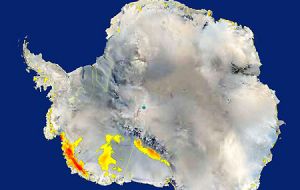MercoPress. South Atlantic News Agency
Western Antarctica ice sheet shrinking at accelerated pace
 Areas of snow melt, shown in yellow and red, as seen by NASA's QuikScat satellite
Areas of snow melt, shown in yellow and red, as seen by NASA's QuikScat satellite Western Antarctica and the Antarctic Peninsula have lost billons of tons of the continent's ice mass which means the Antarctic ice sheet is shrinking and at a rate that has increased dramatically between 1996 and 2006 according to a report published in the latest edition of Nature Geoscience.
"Over the time period of our survey, the ice sheet as a whole was certainly losing mass and the mass loss increased by 75% in 10 years" the study said. According to the leader of the research project, Dr. Eric Rignot, principal scientist for the Radar Science and Engineering Section at NASA's Jet Propulsion Laboratory's in Pasadena, California, the shrinkage can be attributed to an up-welling of warm waters along the Antarctic coast, which is causing some glaciers to flow more rapidly into the ocean. He suspects the trend is due to global warming, and isn't part of a normal natural fluctuation. "I see that as the main driver for the change in ice mass. And this means that we are not in a natural cycle but in something that is related to global warming or global climate change, whichever you want to call it," he said. The study said the continent had a net lost of about 196 billion tons of ice in 2006, up from 112 billion tons in 1996. The figures were calculated by deducting the amount of ice losses on the continent from the amount of snow computer models indicate it receives. The figures were based on satellite data on ice thickness and the speeds at which glaciers are flowing into the ocean. Dr. Rignot said the Antarctic ice loss in 2006 raised sea levels about half a millimetre, putting it on par with the contribution to sea level rise from the recently observed melting of the Greenland ice sheet. Within scientific circles, there is little doubt that Greenland's ice is melting, but there has been more uncertainty over the fate of the larger stores of ice on Antarctica. Some experts have speculated that global warming might lead to increases in ice accumulation in Antarctic's interior due to more snowfall. However, many experts say that this effect is unlikely to offset Antarctica's contribution to sea level rise because of the rapid melting of coastal glaciers. "The concept that global warming will increase precipitation in Antarctica and mitigate sea level rise is a lullaby," Dr. Rignot said. "Our story shows that the main driver for the mass balance is the rate of glacier flow to the sea and not the precipitation rate because other studies already showed recently that the precipitation rate has not changed significantly". Another member of the research team, Curt Davis, director of the Centre for Geospatial Intelligence at the University of Missouri-Columbia, said the new study is the "most comprehensive" to date on the status of Antarctica's ice, and has zeroed in on exactly where the losses are occurring. It found that the biggest losses are in West Antarctica, around the Amundsen Sea, (132 billion tons in 2006 compared to 83 billion in 1996) and in the Antarctic Peninsula (60 billion tons), the continent's distinctive long arm of land that point like a finger up at South America. One encouraging finding from the study is that the largest ice sheet, the one covering East Antarctica, has remained relatively stable, showing a small net gain in size.




Top Comments
Disclaimer & comment rulesCommenting for this story is now closed.
If you have a Facebook account, become a fan and comment on our Facebook Page!